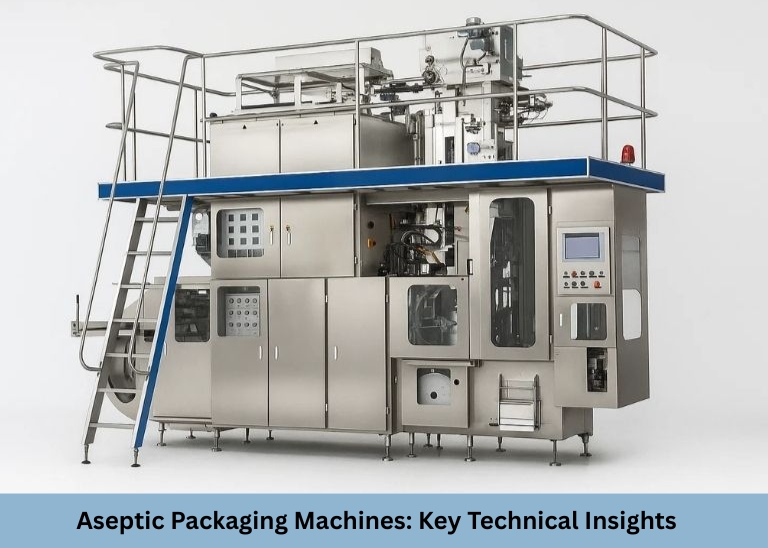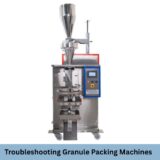Aseptic Packing Machines: Technical & Functional Aspects
Objective of the Article
The objective of this article is to provide a comprehensive understanding of the technical and functional aspects of aseptic packing machines, focusing on their role in preserving the quality and shelf life of products without refrigeration. This article will explore the working principles, key components, sterilization techniques, and the differences between aseptic and conventional filling machines. It will also address the integration of aseptic packing machines with automatic filling and sealing lines, the role of clean room technology, and advanced sterilization methods used in modern aseptic packaging systems. Additionally, the article will highlight important considerations, such as material compatibility, hermetic sealing, and automation in next-generation aseptic packing machines.
Technical & Functional Aspects of Aseptic Packing Machines
Aseptic packing machines are pivotal in the food, beverage, and pharmaceutical industries, providing a solution for preserving products by maintaining their quality and safety without the need for refrigeration. These machines enable the production of shelf-stable products such as dairy, juices, sauces, and medicines by effectively sterilizing both the product and the packaging material before filling. Understanding the technical and functional aspects of these machines is essential for ensuring optimal performance, product safety, and efficiency in production processes.
How Aseptic Packing Machines Preserve Product Shelf Life Without Refrigeration
Aseptic packing machines are designed to extend the shelf life of perishable products without the need for refrigeration. The process involves sterilizing both the product and the packaging materials before the product is filled into the package. By removing harmful microorganisms through sterilization, aseptic packaging prevents spoilage and maintains the product’s nutritional value, taste, and appearance.
- Sterilization of Product: The product is typically sterilized using high-temperature short-time (HTST) methods, where it is heated to a specific temperature for a very short period, killing any harmful microorganisms without compromising the product’s quality.
- Sterilization of Packaging: The packaging materials, such as cartons or plastic pouches, are sterilized using hydrogen peroxide or other sterilizing agents before the product is filled.
- Hermetic Sealing: Once filled, the packaging is hermetically sealed to create an airtight environment, preventing the reintroduction of contaminants and ensuring the product remains shelf-stable for an extended period.
This sterilization process ensures that products like milk, fruit juices, and sauces can be stored at room temperature for several months, reducing the need for refrigeration, cutting energy costs, and improving distribution efficiency.
Understanding the Working Principle of Aseptic Packaging Systems
Aseptic packaging systems rely on the simultaneous sterilization of both the product and the packaging material. The working principle typically involves the following steps:
- Sterilization of Product: The product is heated to a specific temperature (typically above 100°C) for a short time to kill pathogens, followed by rapid cooling.
- Sterilization of Packaging Material: Packaging materials such as cartons, bottles, or pouches are sterilized by exposure to a sterilizing agent (such as hydrogen peroxide) or through heat.
- Filling and Sealing: The sterilized product is then filled into the sterilized packaging, which is done in a sterile environment to avoid contamination. The packaging is then hermetically sealed to maintain sterility.
- Post-Sealing Storage: After sealing, the packaged product is allowed to cool before it is stored, ensuring the product remains sterile and shelf-stable.
This process ensures that the product can be stored for extended periods without refrigeration, offering significant advantages for both manufacturers and consumers in terms of convenience, cost, and product longevity.
Key Components and Sterilization Techniques in Aseptic Packing Machines
Aseptic packing machines comprise several key components that play a crucial role in ensuring the efficiency and safety of the packaging process. Some of these components include:
- Sterilization Unit: A core part of the machine, which sterilizes both the product and the packaging material. Common sterilization methods include HTST (high-temperature short time) for products and hydrogen peroxide for packaging materials.
- Filling System: After sterilization, the filling system ensures the controlled flow of the sterilized product into the packaging. The filling machine must maintain sterility during this process.
- Sealing Mechanism: The hermetic sealing system is responsible for closing the packaging material tightly to prevent contamination after filling.
- Sterile Air Supply: Sterile air is used in some aseptic systems to maintain the cleanliness of the environment in which the product is filled.
- Clean Room or Isolator: A clean room environment, sometimes called an isolator, is crucial for preventing contamination during filling. This component ensures the sterile air quality and clean conditions are maintained during production.
Differences Between Aseptic and Conventional Filling Machines
The primary difference between aseptic filling machines and conventional filling machines lies in their approach to sterilization and preservation:
- Aseptic Filling Machines: Sterilize both the product and the packaging before filling, ensuring that both are free from microorganisms. These machines are designed to operate in sterile environments to maintain product safety and extend shelf life.
- Conventional Filling Machines: Typically, these machines do not sterilize the product or packaging material. Instead, they rely on refrigeration, preservatives, or shorter shelf life for product preservation. These machines are used for products that require refrigeration or a shorter shelf life and are not suited for long-term storage at room temperature.
The aseptic process provides significant benefits for long-term storage and transport, whereas conventional filling machines are more suitable for products with a shorter shelf life that require cold chain logistics.
Integration of Aseptic Packing Machines with Automatic Filling & Sealing Lines
Aseptic packing machines are often integrated with automatic filling and sealing lines to create fully automated systems that increase production efficiency and reduce the risk of human error. The integration of these systems includes:
- Automation of the Filling Process: Aseptic packing machines can be connected to automated filling machines that precisely dispense sterilized products into sterilized packaging.
- Sealing Systems: Automated sealing units ensure that packages are hermetically sealed without any contamination or leakage.
- Quality Control: Automated inspection systems ensure that only properly filled and sealed products are packaged, ensuring high standards of quality.
- End-of-Line Automation: Some systems also include automated packing and palletizing, making the entire process—from sterilization to final shipment—highly efficient.
Role of Clean Room Technology in Aseptic Packaging Operations
Clean room technology plays a critical role in aseptic packaging by ensuring that the filling and sealing processes take place in a controlled, sterile environment. Clean rooms or isolators are designed to minimize contamination by controlling airflow, air pressure, and particle count. These systems help maintain the sterility of both the product and the packaging.
- Air Quality Control: Clean rooms maintain ultra-low levels of airborne particles and microorganisms, ensuring that aseptic filling and sealing can occur without contamination.
- Pressure Control: Maintaining positive air pressure in the clean room ensures that any potential contaminants are pushed away from critical areas of the machine.
- Temperature and Humidity Control: The temperature and humidity are carefully controlled to further reduce the chances of contamination.
Advanced Sterilization Methods Used in Modern Aseptic Packaging Lines
Modern aseptic packaging lines incorporate advanced sterilization techniques to ensure product safety:
- Hot Water Sterilization: This method uses hot water at high temperatures to sterilize equipment and packaging materials.
- Hydrogen Peroxide Sterilization: Often used for sterilizing packaging materials before they come into contact with the product, hydrogen peroxide sterilization is widely used for cartons and plastic packaging.
- UV Sterilization: Ultraviolet (UV) light is used for sterilizing packaging materials in some aseptic packaging systems.
- Steam Sterilization: Steam is applied to sterilize both the product and certain parts of the machine, ensuring effective microbial elimination.
Material Compatibility: Choosing the Right Packaging Material for Aseptic Systems
Choosing the right packaging material is crucial for maintaining the efficacy of the aseptic packaging process. Common materials used in aseptic packaging include:
- Paperboard: Often used for liquid products such as juices, soups, and dairy products. The paperboard is coated with a thin layer of polyethylene or aluminum to make it resistant to moisture and oxygen.
- Plastic (Polyethylene and Polypropylene): Used for aseptic pouches and bottles, plastic materials must be resistant to heat and capable of maintaining product sterility.
- Glass: In some cases, glass bottles are used for aseptic packaging, particularly in premium or high-value products.
The material must be compatible with the sterilization method used and maintain the product’s safety and quality during storage and transport.
The Importance of Hermetic Sealing in Aseptic Filling Machines
Hermetic sealing is a critical component of aseptic filling machines, ensuring that the packaging is completely airtight. This type of sealing prevents microbial contamination after the product is filled, extending the shelf life of the product. A proper hermetic seal also helps:
- Preventing Spoilage: By keeping air, moisture, and contaminants out, hermetic sealing ensures the product stays fresh and safe for long periods.
- Maintaining Product Quality: The seal prevents oxygen and light exposure, which could degrade the product over time.
- Ensuring Transport Safety: Hermetic seals help prevent leaks during storage and transport.
Automation and PLC Control in Next-Generation Aseptic Packing Machines
Next-generation aseptic packing machines feature automation and Programmable Logic Controller (PLC) control systems, allowing for greater efficiency and precision:
- Automation: Reduces the need for manual intervention, speeding up production and minimizing human error.
- PLC Control: The PLC system offers precise control over the machine’s operations, including sterilization parameters, filling volume, and sealing integrity. It also facilitates real-time monitoring and data logging for quality control and maintenance purposes.
This technological integration improves both the consistency and reliability of the aseptic packaging process.
Conclusion
Aseptic packing machines are indispensable in industries that require long shelf life for products without refrigeration. By understanding the technical and functional aspects of these machines—from sterilization techniques and key components to automation and material compatibility—companies can optimize their aseptic packaging processes for improved product safety, quality, and efficiency. As the demand for shelf-stable products continues to grow, advancements in aseptic packaging technology will play a crucial role in meeting global consumer needs while ensuring sustainability and cost-effectiveness.

CEO
With over 10 years of experience in the packaging machinery industry, Rohan Thomas leads Fair Pack Machineries (Pvt) Ltd., a trusted manufacturer and exporter of advanced packaging solutions. The company specializes in automatic and semi-automatic filling, sealing, and conveyor systems designed for powders, granules, liquids, solids, and pastes. Under his leadership, Fair Pack serves diverse sectors including food, FMCG, pharmaceuticals, automobile, and industrial applications, providing machinery that combines innovation, reliability, and efficiency.
With a strong presence in both Indian and international markets, Fair Pack Machineries is known for its commitment to quality, customer support, and turnkey packaging solutions. Rohan focuses on driving growth through technology-driven products, global partnerships, and ensuring clients receive tailored solutions that meet international standards. His vision is to strengthen Fair Pack’s reputation as a global partner in packaging machinery while enabling businesses to scale with sustainable and cost-effective systems.


